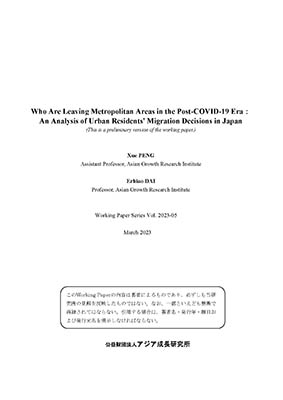Who Are Leaving Metropolitan Areas in the Post-COVID-19 Era : An Analysis of Urban Residents' Migration Decisions in Japan

| Author | Xue PENG, Erbiao DAI |
|---|---|
| Date of Publication | 2023.3 |
| No. | 2023-05 |
| Download | 979KB |
Contents Introduction
Japan's central and local governments have implemented various measures to encourage internal migration from metropolitan areas to local areas to address issues related to population decrease and unbalanced regional development. However, despite a significant decrease in net migration flow from Japan's local areas to main metropolitan areas over the past 50 years, the net outflow from metropolitan to local areas has remained negative. This suggests that Japan's population migration spatial pattern is more difficult to change than that of developed countries in Europe and America. On the other hand, the three-year-long COVID-19 pandemic has brought significant changes to people's work, consumption, learning, and daily life. Will such changes affect Japanese residents' residential location choices and migration patterns? This paper uses data from "The Fifth Survey on Residents' Life Consciousness and Behavior Changes under the Influence of COVID-19" and a multinomial logit model to conduct empirical analysis. Our findings suggest that individuals who are more likely to leave metropolitan areas are those with relatively low job opportunity costs in metropolitan areas and high employment probabilities in local areas, young adults who have entered the labor market within the past ten years, individuals who have been retired for a few years, and those who prioritize their well-being. In contrast, household-related factors such as marital status, having underage children, and the work status of residents' spouse did not significantly affect their decision to move. These results provide new evidence to support major migration theories. Based on our analysis, policy recommendations are also discussed.
